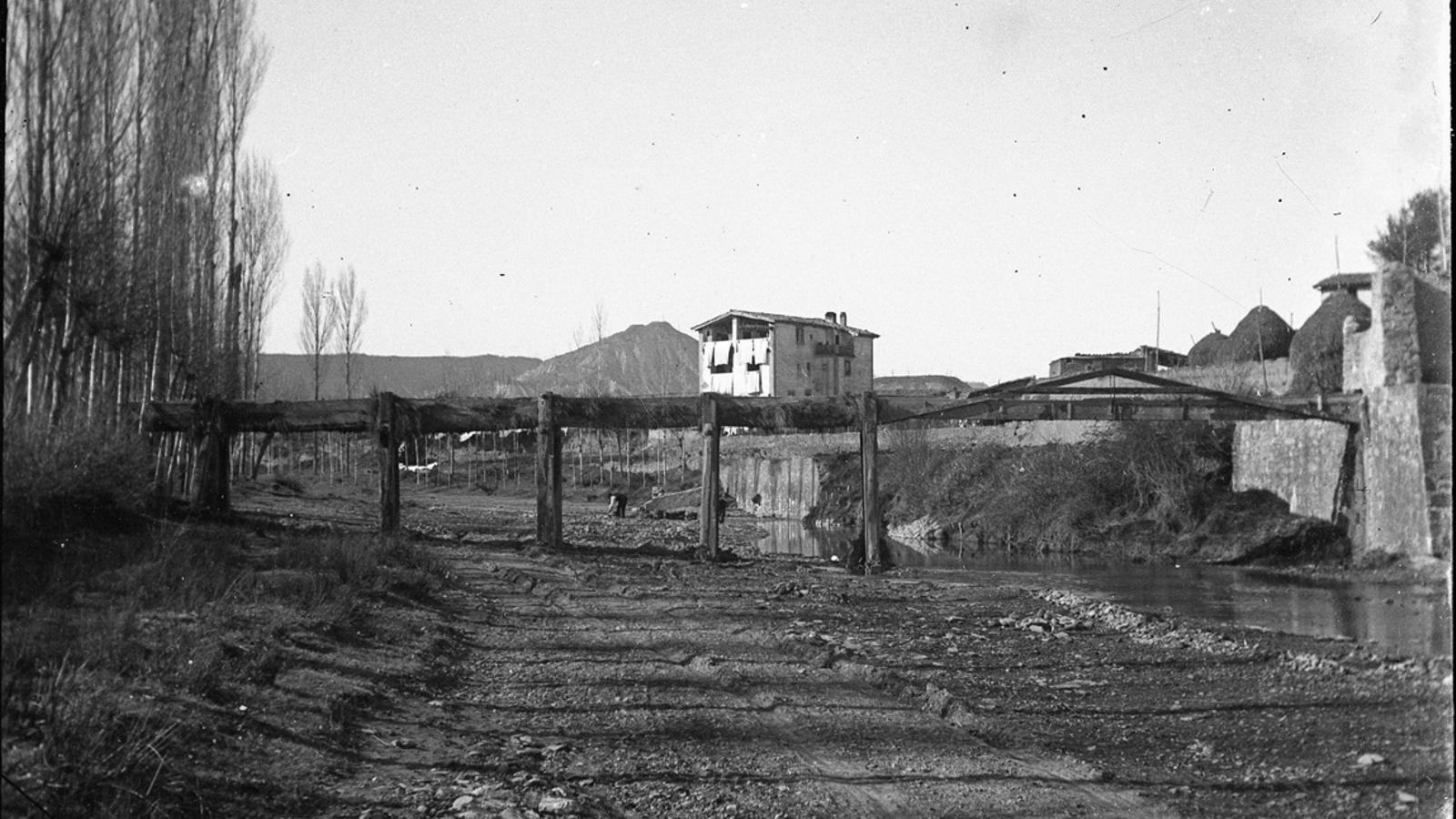There are numerous vestiges of ancient irrigation ditches throughout the country. Xavier Cervera, from Vic, has dedicated himself to finding traces of the so-called Marquès irrigation ditch, to commemorate the 75th anniversary of Aigües Vic. Now you can draw your route on the map with extreme precision, and you can recognize it from a distance, especially since the rows of trees and reeds are the best indicator.
Today, I'm invited to explore these traces of the irrigation ditch that originated in the small village of Sentfores (known as La Guixa, part of Vic) and flowed into the Mèder River. Its course is dotted with fountains and wells. The starting point of our route is the so-called Call well. This well was in fairly poor condition and has been restored. I turn the "wheel," which causes the water to rise. It comes out in torrents.
The people of Guixa came with jugs, buckets, and all kinds of vessels to fill with water, for drinking and washing. They also brought their animals to drink. All this happened before there was running water.
The elders of La Guixa still remember when water flowed down the Marquès irrigation ditch, which fell into disuse when the public water network arrived. Many farmhouses then electrified their wells and were able to pump water in large quantities.
When we are At the foot of a dam, which still retains water from the River Mèder and spills out in the form of a waterfall, Xavier tells me that it was built in the 18th century by the Marquis of Cànoves to divert water to the irrigation ditch, which irrigated orchards and powered mills. Now, there is no water entering the ditch, and therefore the remaining sections are completely dry.
Below the dam is the Iron Fountain, and a little further on is the Atalaya Fountain, which was frequented by students from the Vic Seminary.
We're now in Can Rafel's vegetable garden. "Their produce is sold every Saturday at the Vic market, in the Plaza Mayor; it's practically kilometer zero," says Xavier Cervera, founder of Forum Vicus, a company that organizes guided tours of Vic and the surrounding area. When he was just seven years old, taking advantage of a few days of summer vacation with his grandparents, Xavier would improvise guided tours of the Sanctuary of La Salud for the parade-goers. As a child, he also accompanied the bell ringer of Vic Cathedral on Sunday afternoons and the groups that visited, and occasionally gave some of the explanations. He made his debut as a guide. official taking a tour of Vic's ancient niches. He then led tours of Vic's cemetery, the city's old hospitals, and historic bridges and paths.
"The water from the Mèder River reached this point during the downpour of 1863, a tragedy that caused many deaths," Xavier tells me when we're at the Blanqueo de la Codina farmhouse, which is located quite a bit further upstream. It has a really large well. A mill returned the water, which was used to bleach fabrics. "Do you see the fields, all flat?" Xavier asks. "Well, this is probably where they used to spread the bleached fabrics," he explains.
We walk along a shaded path that runs alongside the river. Suddenly, Xavier says to me, "Look, the swimming pools in Vic!" I have a hard time imagining a small pool in the river being a swimming pool, much less a pool in the plural. Xavier explains that many people from Vic used to come here to swim, during such a difficult time as the Civil War and the postwar period, when leisure, nevertheless, was necessary. What a contrast with 21st-century Catalonia, where there are large municipal swimming pools. unnatural –with a lifeguard and everything– in a lot of towns, no matter how small!
It must be said that in these swimming pools There was more water because a lock, built to hold enough ice, formed a small reservoir. Yes, in winter, with the low temperatures, the river froze. Blocks of ice were then cut with saws and deposited inside the square ice well next to it, which has been partially preserved.
Ice had many uses: to preserve fish and delicate foods, to make ice cream and pastries, and also to treat certain ailments, such as burns, hemorrhages, fevers, etc.
The Marquis irrigation ditch returned to the Mèder, from where it had originated, in the heart of Vic, in what is now Parc Balmes, the last stop on our route. "Do you see these two buildings slightly separated? They are the old Dominican convent and the priest's house. Well, the irrigation ditch used to flow through the gap between them," Xavier tells me in Parc Balmes. Right in front of the two buildings is a spring (which reaches quite a height—the water is higher than a person's height). Seeing so much water might lead some to think—mistakenly—that the drought is over for good.
The terrible downpour of the early morning of October 8, 1863
In the early hours of October 8, 1863, a downpour completely flooded the Mèder River, sweeping away everything: animals, trees, houses, and even people, who disappeared forever beneath the water and mud. Many bodies were found with their clothes half-dressed, as the flood caught many people in Vic asleep.
It is explained in detail in Desgracias de Vich , a text written by Dr. Joaquim Salarich, which has the subtitle A Brief History of the Misfortunes Caused by the Méder Avenue in the Morning of October 8, 1863. " So terrible were the ravages caused by the mysterious downpour that the heart shudders and the spirit is afflicted when remembering them, and the uncertain pen can barely manage to draw these lines ," says Salarich at the beginning of the publication, which explains in detail both the tragedy and the heroic acts it generated.


